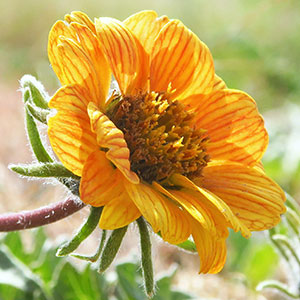Balsamorhiza rosea
rosy balsamroot
blades gray-green, oblong to lance-ovate, 3–10(–20) × 2–5 cm (rarely pinnately lobed), bases weakly cordate or truncate, margins crenate to serrate, apices rounded to acute, faces finely strigose to moderately scabrous (usually gland-dotted as well).
hemispheric, 18–20 mm diam.
(becoming brick-red, often drying to pink or rose, and chartaceous) (8–)15(–25) mm (hispidulous abaxially; cypselae strigose).
deltate or ovate to lanceolate, 8–12 mm, not surpassing inner.
usually borne singly.
= 38.
Balsamorhiza rosea
In a hybrid swarm involving Balsamorhiza rosea and B. careyana, B. rosea remains relatively uncontaminated; the dominance among the hybrids appears to lie with B. careyana. A record of a hybrid between B. rosea and B. careyana from the Spokane area is doubtful.
(Discussion copyrighted by Flora of North America; reprinted with permission.)


